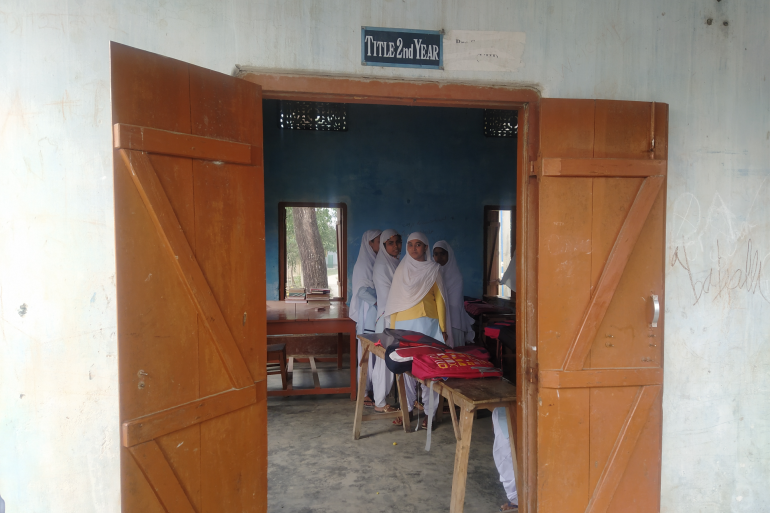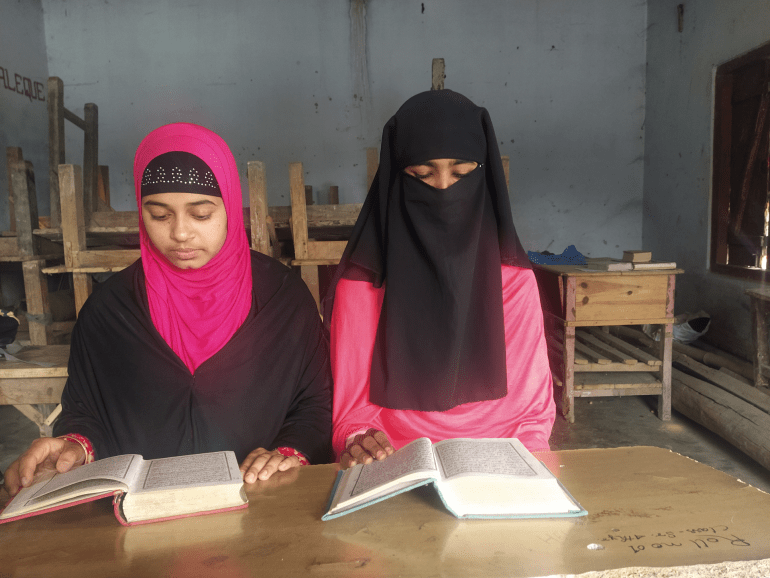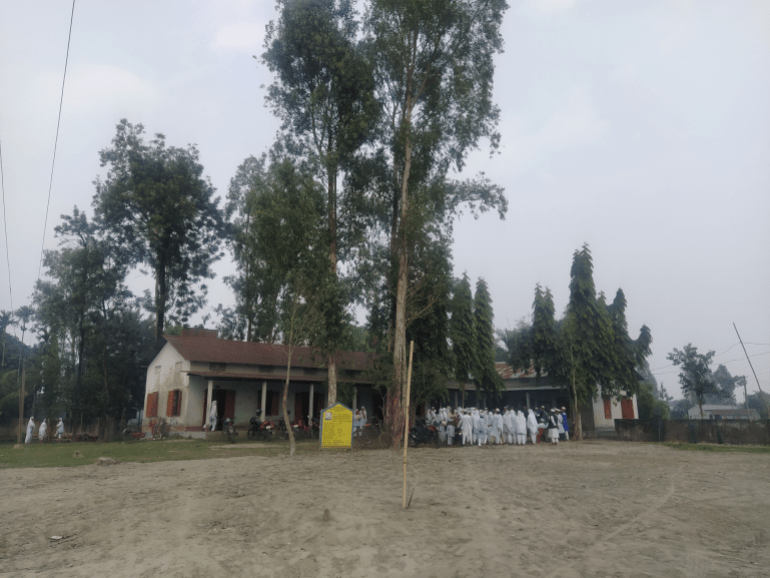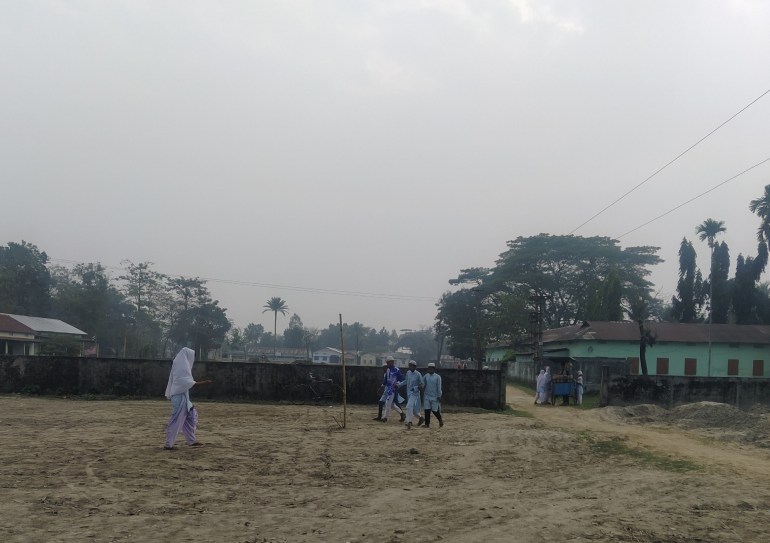In Assam, ban on state-run madrassas may force girls to drop out
Educators and activists fear a mass dropout of female Muslim students in India’s Assam state as madrassas are converted into general schools.

Barpeta, India – It has been nearly a year since 12-year-old Ayesha Siddiqa has been confined to her house in India’s northeastern state of Assam due to COVID-19 restrictions.
Her school in Gomafulbaru in the Barpeta district offered online classes, but the grade 6 student could not attend, as her parents cannot afford a smartphone.
Keep reading
list of 4 itemsIn India’s Assam, a young Muslim leader fights election to unite
127 Indian Muslims charged with ‘terror’ acquitted after 19 years
Rise of BJP in former communist bastion has Muslims worried
Siddiqa lives with her parents and younger brother in a char – a remote riverine island formed by siltation of the Brahmaputra river that cuts through the state of nearly 30 million. Her father Abed Ali, 45, and mother Gulbahar Nesa grow rice on rented farmland, but struggle to make ends meet.
Come April, however, Siddiqa will no longer be able to continue her studies, as the Gomafulbari Title Madrassa – a government-funded school that also offered Islamic education – will cease to exist.
In December, the state government led by the Hindu nationalist Bharatiya Janata Party (BJP) announced it will convert all government-funded madrassas into regular schools and drop theological components from their syllabi.
More than 700 state-run madrasas will be shut down, affecting 98,000 students, of whom nearly half are girls, according to figures from the State Madrassa Education Board (SMEB). Like elsewhere in India, the literacy rate (61.92 percent) and percentage of students who complete matriculation or 10th board (2.8 percent) is lowest among Muslims in Assam, as per 2011 Census data.
Affect girl students
Members of the Muslim community and activists say the decision will particularly affect the education of Muslim girls as many parents, who prefer girls to get Islamic education along with regular subjects, will pull their daughters out of the schools.
The female literacy rate is particularly low among Assam’s Muslims, most of whom are poor and sit at the bottom of development indices.

“If the madrassa is closed down, we’ll have to pull her out of school. I cannot afford to send her to a private madrassa on my meagre earnings,” Ali told Al Jazeera.
Although there is a high school in the village, he sent his daughter to the state-run madrassa, which offered both Islamic and general education.
In the state-run madrassas, apart from Islamic studies and languages such as Arabic and Urdu, general subjects including maths, sciences, social studies and other modern Indian languages were also taught.
“We are poor people so it’s important for her to get a religious education to improve her marital prospects,” he added. “It saves us the expenses for her dowry. In fact, the groom will offer something in exchange for her hand.”
Naznima Akhtar and Fatima Afreen are back in school after almost a year since the coronavirus pandemic hit last March. Until January, their classes were online and home assignments would be delivered on WhatsApp.
The girls, both 17, are in their first year of Fadilul Ma’rif (FM), a three-year theological degree course equivalent to a bachelor’s degree in general education at Gomafulbari Senior Madrasa in Barpeta district. Fiqh (Islamic Law) and the Quran are their favourite subjects.
‘Imbibe the values Islam’
As per the new law, only second year FM and Mumtazul Muhatditthin (MM) students would be allowed to complete their course up to 2022, forcing students like Akhtar and Afreen to either continue in general education or drop out. MM is equivalent to a postgraduate degree in theological studies of the Hadith and Quran.
Akhtar, who wants to study up to MM course, said she will have to move to another school if the Quran is no longer in the curriculum.
“My parents want me to work hard and make something of myself in life. At the same time, they want me to imbibe the values and tenets of Islam,” she said.
Established in 1972, the Gomafulbari Title Madrassa was originally started as an institution for girls by Ahmed Ali Khan, an educationalist based in Barpeta district, which has a majority Muslim population.
Unlike other madrassas nearby in the village, girls heavily outnumber boys in Gomafulbari Title Madrassa.
It was merged with the Gomafulbari Senior Madrassa, which was founded in 1942 before India’s independence from British colonial rulers. It is sought-after as it offers FM and MM courses.
Rustam Ali Dewan, headmaster of the Gomafulbari Title Madrassa, said that the parents and local guardians are unhappy with the government’s decision.

“They see it as an attack on their religion and are asking us to do everything to reverse this move,” he told Al Jazeera.
Akhtar’s father, Naseeruddin Khan, who works as a government employee, said that the conversion would lead to a lot of difficulties for his daughter’s education.
“We like that she is exposed to both religious and general subjects. That way she has an equal chance to pursue a higher degree in Islamic studies or go into a general stream like BA (Bachelor of Arts), LLB (Bachelor of Laws) etc,” he said.
Mahmud Hassan, a class nine student at Gomafulbari Title Madrassa, said that he may continue studying in the same school but will have to travel further to a private madrassa for Islamic studies.
“However,” he added, “not everyone has that privilege in terms of time and money. A lot of girls studying here will not be allowed to do the same.”
Private madrassas
Private madrassas typically offer food and boarding to lower socio-economic status students. However, Dewan from the Gomafulbari Title Madrassa said, these are hardly an alternative to the state-run madrassas.
“In the private-run madrassas, they simply memorise the holy book in Arabic with no understanding of it,” he told Al Jazeera.
“Moreover, these aren’t regulated by any state board. So education here will ultimately be useless for students to pursue higher studies or get a job,” he added.
Parvin Sultana, an assistant professor in Pramathesh Barua college in Assam, said the privately-run madrassas required reform.
“If girls are shifted to private madrassas where modern education is not a part of curriculum, it will foreclose any possibility of socio-economic empowerment of Muslim girls,” she said.
The Assam State Jamiat Ulema-e-Hind – a religious organisation based in Nagaon district, runs 987 madrassas in mainly Muslim-majority regions of the state.
Masood Zaman, a spokesperson of the legal cell of the Jamiat Ulama, defended the quality of education in madrassas saying they are run under the Assam Tanzim Board – a private body that monitors the quality of education in private madrassas.
The Tanzim Board is supervised by the Darul Uloom Deoband Islamic university based in northern Uttar Pradesh state – India’s largest madrassa.
Zaman said that nearly 100 out of 987 madrassas run by his organisation are exclusively for girls, and that his organisation is working to improve the quality of education in private madrassas.
“At least 150 madrassas are waiting to be included under the Tanjim board, pending fulfilment of requirements like classroom, teacher-student ratio, playground etc,” Zaman told Al Jazeera.
Anti-Muslim agenda
Some activists and opposition parties said the move was part of the right-wing government’s anti-Muslim agenda and was aimed at appealing to Hindu voters ahead of the upcoming state elections.
But the government said the move was aimed at “secularising” school education in the state. The state’s influential education minister, Himanta Biswa Sarma, defended the move, citing the ban on Sanskrit schools, known as tols.
But critics said the government has projected madrassas as “obscurantist and outdated” institutions while Sanskrit tols would be converted into academic institutes researching on “Indian civilisation”.
Dewan, headmaster of the Gomafulbari Title Madrassa, said that the conversion of madrassas and Sanskrit tols, which Assam’s Education Minister touted as “secular”, were not the same.
“Unlike the madrassas, the Sanskrit tols will be upgraded to university level education,” he told Al Jazeera.
But Imran Hussain, chairman of the SMEB Assam, supported the government’s move. “General education will help uplift the (Muslim) community in mainstream jobs. Whereas in madrassas, there’s a likelihood of ghettoisation,” he told Al Jazeera.
One-third of the state’s population comprises Muslims, most of them of Bengali origin.
Hussain, the SMEB chairman, said the Sachar Committee report released in 2006 should be consulted in planning education policy for Muslims. “One must consult the Sachar Committee report to see what needs to be done for the Muslims,” Hussain told Al Jazeera.
The Rajinder Sachar committee instituted by the central government had found that the literacy rate among Muslims was far below the national average and the minority community is at the bottom of most development indicators.
The ruling BJP party defends the move
Activists like Sultana foresee a possibility where the closure of government madrassas could put young girls at risk of early marriage, a problem that continues to afflict the community.
A 2020 study on education of female Muslims in Nagaon district of Assam found that the mother’s education had a significant effect on fertility and the overall development of a family.
India’s largest minority has faced increased attacks by Hindu far-right groups linked to the BJP since Narendra Modi took over as prime minister in 2014.
But Pabitra Margherita, a spokesperson of the BJP in Assam, defended the government move, saying a “limited section” of parents wanted to send their daughters to Islamic studies.

“This year we have budgeted for special schools covering normal curriculum in minority dominated districts, especially for girl students,” he said, adding that the proposal was moved before the assembly passed the law in December.
Dewan from the Gomafulbari Title Madrassa, said the new law was another nail in the coffin for the Bengali-speaking Muslim minority community in Assam, already targeted by the movement to identify undocumented immigrants through the National Register of Citizens (NRC).
In 2019, nearly two million people of Bengali origin, both Hindus and Muslims, were excluded from a citizenship list published in 2019, effectively rendering them stateless.
Moreover, a number of Muslim poets of the Miya language have faced police cases for their poetry.
“This government has been critical of our mother tongue (Bengali) or the poetry we write,” Dewan said. “But it is in state-run madrassas where students first learn the Quran in Assamese.”
Sultana, the activist, said that while some parents might discontinue their girls’ education, others could shift them to private madrassas “where modern education is not a part of curriculum”.
“It forecloses any possibility of socio-economic empowerment of Muslim girls,” she told Al Jazeera.